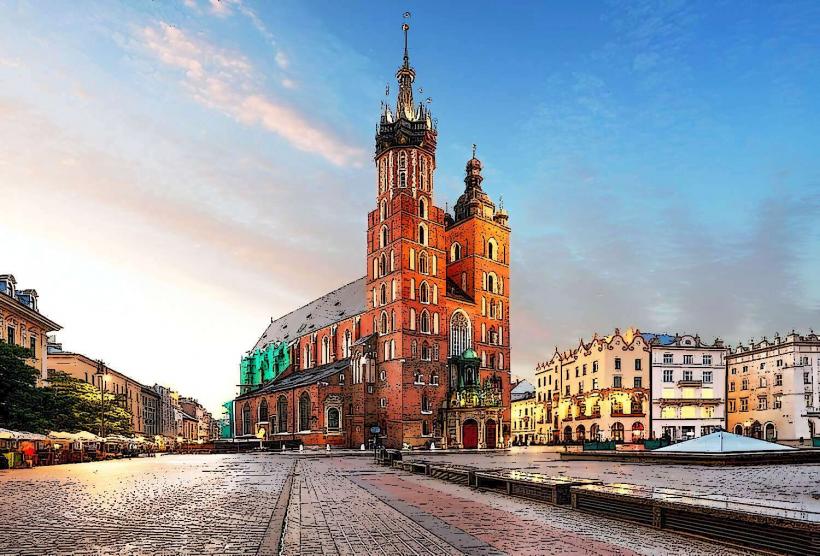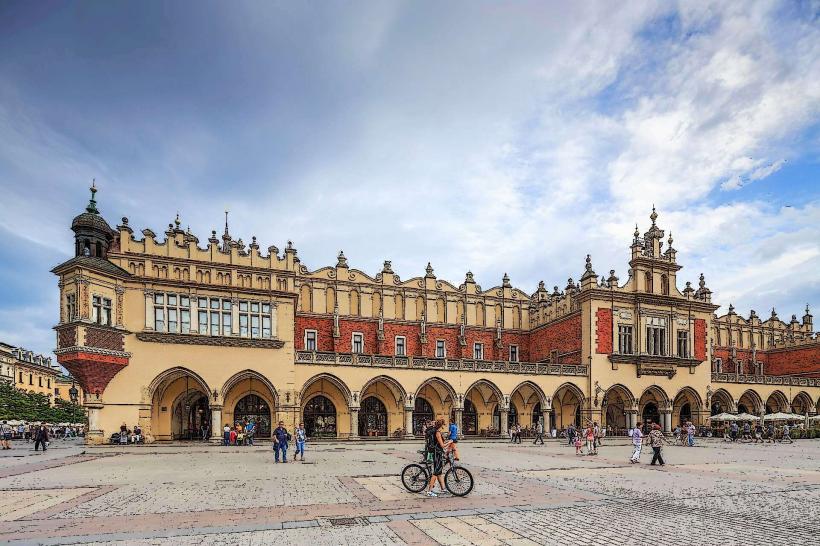Information
Landmark: Wawel CastleCity: Krakow
Country: Poland
Continent: Europe
Wawel Castle (Polish: Zamek Królewski na Wawelu) is one of the most iconic and historically significant landmarks in Kraków, Poland. It is a symbol of the country’s royal heritage and has played a central role in the political, cultural, and religious life of Poland for centuries. Situated on Wawel Hill, overlooking the Vistula River, Wawel Castle served as the residence of Polish kings and is now a major museum and national treasure.
History and Significance
Origins: The history of Wawel Castle dates back to the 10th century, when it was first established as a seat for the Polish rulers. By the early 12th century, the castle had become the official residence of the Polish monarchs, making it the political center of the kingdom. The castle underwent numerous expansions and renovations over the centuries, reflecting changes in architectural styles and the evolving needs of the monarchy.
Royal Residence: Wawel Castle was the home of Polish kings from the reign of Casimir III the Great (1333–1370) through to the final Polish monarch, Stanisław II August (1764–1795). The castle’s role as the political heart of Poland continued until the partitions of Poland in the late 18th century, after which Poland lost its independence.
Symbol of Polish Identity: Over the centuries, Wawel Castle became a symbol of Polish national identity and sovereignty. It witnessed the coronation of Polish monarchs, the signing of important treaties, and the housing of royal treasures. Even after Poland’s partitions and eventual loss of independence, Wawel Castle remained a symbol of the country’s past glory and a rallying point for Polish national sentiment.
Post-Independence: After Poland regained independence in 1918, Wawel Castle became a key part of the country’s cultural heritage. It was officially designated as a museum, and the castle's historical collections were made available to the public.
Architecture
Wawel Castle is a stunning example of architectural evolution, as it incorporates various styles from different periods, including Romanesque, Gothic, Renaissance, and Baroque. The castle complex consists of several buildings and courtyards, each with its own unique architectural features.
Wawel Cathedral: One of the most notable features of the castle complex is the Wawel Cathedral (Cathedral of St. Stanislaus and St. Wenceslaus), located next to the castle itself. The cathedral has served as the coronation site for Polish monarchs and is the final resting place of many of them, as well as other prominent figures from Polish history.
Renaissance Architecture: The Renaissance style is perhaps the most prominent architectural influence on Wawel Castle, particularly during the reign of Sigismund I the Old (1506–1548). The Royal Chambers, Sigismund's Chapel, and the Wawel Courtyard showcase this style with symmetrical design, arcades, and fluted columns.
Royal Apartments: Inside the castle, the Royal Apartments offer a glimpse into the luxurious life of Polish monarchs. These rooms are furnished with tapestries, paintings, furniture, and decorative arts from various periods, giving visitors an idea of the royal court’s grandeur.
The Castle Courtyards: The castle is organized around several courtyards, including the Inner Courtyard and the Outer Courtyard, which are connected by arcades and open spaces. The courtyards are surrounded by impressive architectural facades and offer beautiful views of the city and surrounding landscape.
Museum and Collections
Today, Wawel Castle serves as a museum that is part of the State Art Collections and houses a wide range of exhibits, including historical artifacts, royal treasures, and artistic works. Some of the most notable collections and areas within the castle include:
Royal Chambers: The Royal Chambers are a series of rooms within the castle that are part of the museum. They feature furniture, tapestries, portraits, and other objects that belonged to the Polish kings and queens.
The Crown Treasury and Armoury: The Crown Treasury holds some of Poland's most valuable royal treasures, including the Crown Jewels and ceremonial weapons. The Armoury displays a rich collection of historical weapons, armor, and other military artifacts.
The State Rooms: These rooms were used for official ceremonies and receptions. They are furnished with pieces of European fine art, decorative arts, and luxurious furnishings. The Throne Room and Ballroom are key features of this section.
The Wawel Cathedral: The cathedral is home to many royal tombs and is a central feature of the Wawel complex. It contains Polish monarchs' tombs, such as those of Władysław Jagiełło, Stanisław August Poniatowski, and Józef Piłsudski. The cathedral’s Sigismund Chapel, a Renaissance masterpiece, is one of the most famous features of the church.
The Lost Wawel Exhibition: This exhibition showcases the archaeological history of the Wawel Hill, offering insight into its origins as a settlement dating back to the early medieval period. It also features a reconstruction of the early royal residence and the palace that once stood on the hill.
The Dragon’s Den: According to legend, the castle is home to the Wawel Dragon, a mythical creature that was said to have lived in a cave beneath the hill. Visitors can explore the cave, known as the Dragon’s Den, located at the foot of the castle.
The Wawel Dragon Legend
One of the most enduring legends associated with Wawel Castle is the story of the Wawel Dragon. According to Polish folklore, the dragon lived in a cave beneath Wawel Hill and terrorized the local population by devouring livestock. The legend states that a brave young man named Krakus (the founder of Kraków) managed to defeat the dragon by tricking it into eating a poisoned sheep. After the dragon drank from the Vistula River to quench its thirst, it exploded. This victory led to the founding of the city of Kraków.
Today, the Wawel Dragon Statue, located near the castle, spouts fire at regular intervals, drawing both tourists and locals to witness the spectacle.
Visitor Experience
Wawel Castle is one of Poland’s most visited tourist attractions, drawing millions of visitors each year. Visitors can tour the castle’s many rooms, gardens, and exhibitions, and explore the extensive collections on display. The castle also hosts events, concerts, and special exhibitions, making it a lively cultural hub in Kraków.
Opening Hours and Tickets: Wawel Castle is open to the public year-round, with special events and temporary exhibitions being held regularly. Visitors can purchase tickets to different sections of the castle, depending on their interests (e.g., the Royal Chambers, Crown Treasury, Wawel Cathedral, etc.).
Wawel Hill and Surroundings: The castle’s location on Wawel Hill provides stunning views of the Vistula River and the Kraków skyline, making it a great spot for photography and sightseeing. The surrounding area is also home to beautiful parks and gardens, including the Wawel Gardens.
Conclusion
Wawel Castle is a must-see destination for anyone visiting Kraków. With its rich history, impressive architecture, and significant cultural heritage, it stands as one of the most important historical sites in Poland. Whether you are interested in Polish history, architecture, art, or legends, Wawel Castle offers a fascinating experience that connects visitors to centuries of royal tradition and national pride.



